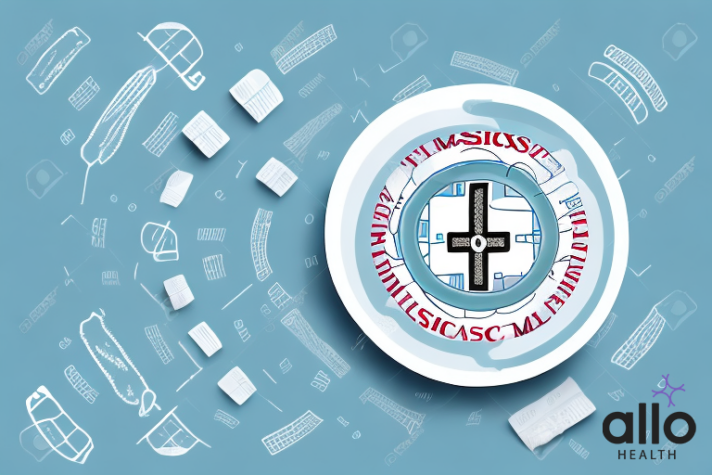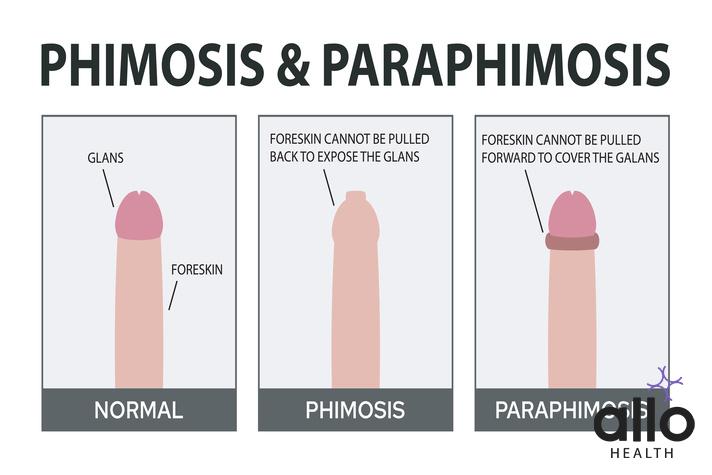What Is Paraphimosis Treatment Cream?

Allo Health is dedicated to personalized well-being, offering support and trusted information tailored to individual health goals. The platform emphasizes human-generated content, led by a distinguished medical team of experts, including physicians and sexual health specialists. Their commitment to credibility involves rigorous fact-checking, authoritative research, and continuous updates to ensure accurate, up-to-date information. Allo Health's unique approach goes beyond conventional platforms, providing expert-led insights and a continuous commitment to excellence, with user feedback playing a crucial role in shaping the platform's authoritative voice.

Dr Sanina Mansoor holds MBBS degree from Yenepoya university,Mangalore.She has 8 years of experience working as a medical officer at various health centres and medical colleges.
Why This Was Upated?
Our experts continually monitor the health and wellness space, and we update our articles when new information became available.
Updated on 04 June, 2024
- Article was updated as part of our commitment to diversity, equity, and inclusion.

"The following blog article may discuss medical treatments and interventions. However, it is important to note that the information provided is for general educational purposes only and should not be considered as a substitute for professional medical advice, diagnosis, or treatment. Always seek the guidance of a qualified healthcare professional for personalized medical advice.
Book consultation
Medical treatments are complex and should be tailored to individual circumstances. The information presented in this blog may not be applicable to everyone, as each person's medical condition, history, and needs are unique. Only a qualified healthcare professional can evaluate your specific medical situation, consider relevant factors, and provide appropriate recommendations for diagnosis, treatment options, and monitoring.
It is crucial to note that self-diagnosis, self-medication, or relying solely on the information provided in this blog for treatment decisions can have serious health consequences. "
Paraphimosis is a condition that occurs when the foreskin of the penis becomes trapped behind the glans. This can lead to swelling and discomfort, and in severe cases, can even cause long term damage to the penis. Fortunately, there are a variety of treatments available for paraphimosis, including the use of creams. In this article, we will explore the benefits of using a cream for the treatment of paraphimosis and provide an in-depth look at how cream can help men overcome this painful and potentially damaging condition.
What Is Paraphimosis Treatment Cream?
Paraphimosis is a medical condition in which the foreskin of the penis becomes trapped behind the glans and cannot be pulled back to its normal position. It is considered a medical emergency because it can lead to reduced blood flow to the glans, causing swelling and potential complications.
The treatment for paraphimosis typically involves manual reduction, where a healthcare professional or a trained individual gently manipulates the foreskin to return it to its normal position. This may be done with the use of lubrication to reduce friction and ease the process.
While there isn’t a specific “paraphimosis treatment cream” that is universally prescribed, topical corticosteroid creams may be used in some cases. These creams contain corticosteroid medications, which have anti-inflammatory properties. The use of a corticosteroid cream can help reduce swelling and inflammation, making it easier to manually reduce the foreskin.
It’s important to note that the use of any medication, including creams, should be done under the guidance and supervision of a healthcare professional. Self-diagnosis and self-treatment can lead to complications, and paraphimosis should be addressed promptly by a medical professional.
In severe cases or if conservative measures are not successful, a healthcare provider may consider other interventions, such as making a small incision in the foreskin (dorsal slit) or, in extreme cases, performing a circumcision.
If you suspect you or someone else is experiencing paraphimosis, seek medical attention immediately. Delayed treatment can lead to complications such as tissue damage, infection, or impaired blood flow, which may result in more serious consequences.
Types Of Paraphimosis Treatment Creams
There isn’t a specific type of cream exclusively designed for treating paraphimosis. However, topical corticosteroid creams are commonly used in some cases to aid in the treatment of paraphimosis. These creams contain corticosteroid medications, which have anti-inflammatory properties that can help reduce swelling and inflammation associated with paraphimosis.
- Hydrocortisone Cream: Hydrocortisone is a mild corticosteroid commonly found in over-the-counter creams. It can be applied topically to the affected area to help alleviate inflammation and reduce swelling. However, the use of hydrocortisone for paraphimosis should be done under the guidance of a healthcare professional.
- Prescription-Strength Corticosteroid Creams: In more severe cases of paraphimosis, healthcare providers may prescribe stronger corticosteroid creams that contain medications like betamethasone or clobetasol. These creams are applied topically and are intended to be used for a short duration under medical supervision.
It’s important to note that the use of these creams is often part of a comprehensive treatment plan that may include manual reduction of the foreskin. The choice of a specific corticosteroid and its concentration depends on the severity of the condition and the healthcare provider’s assessment.

Considerations and Precautions:
- Medical Supervision: The use of any paraphimosis treatment cream, including corticosteroids, should be done under the supervision of a healthcare professional.
- Short-Term Use: These creams are typically prescribed for short-term use to avoid potential side effects associated with long-term corticosteroid use.
- Appropriate Application: Follow the healthcare provider’s instructions for the correct application of the cream. It should only be applied to the affected area, and contact with unaffected areas should be avoided.
- Monitoring for Side Effects: Regular monitoring for side effects, such as skin thinning or irritation, is essential. Report any concerns to a healthcare provider promptly.
While corticosteroid creams can be beneficial in reducing inflammation, they are not a standalone treatment for paraphimosis. Severe cases may require more invasive interventions, and medical guidance is crucial for effective and safe management.
Paraphimosis Treatment Cream Benefits And Uses
Paraphimosis is a medical condition in which the foreskin becomes trapped behind the glans and cannot be pulled back to its normal position. Treatment typically involves manual reduction, but in some cases, healthcare professionals may use topical corticosteroid creams as an adjunct to help alleviate symptoms. Here are some potential benefits and uses of paraphimosis treatment creams:
- Anti-inflammatory Properties: Topical corticosteroid creams contain medications that have potent anti-inflammatory effects. In the context of paraphimosis, inflammation is often present due to the constriction of the foreskin behind the glans. The application of a corticosteroid cream can help reduce this inflammation.
- Reduced Swelling: Swelling is a common symptom of paraphimosis and can contribute to the difficulty in repositioning the foreskin. Corticosteroids can help reduce swelling, making it easier to manually manipulate the foreskin back to its normal position.
- Facilitates Manual Reduction: The primary treatment for paraphimosis involves manually reducing the foreskin to its normal position. The use of a corticosteroid cream, in conjunction with other measures, may make this process smoother by reducing inflammation and swelling.
- Pain Relief: Paraphimosis can be painful due to the constriction and swelling. Corticosteroids may help alleviate pain and discomfort associated with the condition.
- Adjunct to Conservative Measures: Corticosteroid creams are often used as an adjunct to conservative measures such as manual reduction and lubrication. These creams are not typically the sole treatment but may enhance the effectiveness of other interventions.
It’s important to note that the use of any medication, including topical corticosteroids, should be under the supervision of a healthcare professional. Self-diagnosis and self-treatment can lead to complications. If paraphimosis is suspected, it is crucial to seek prompt medical attention for proper evaluation and management.
Additionally, while corticosteroid creams may offer benefits in certain cases, they are not a universal treatment for paraphimosis. In severe cases or when conservative measures fail, more invasive interventions such as a dorsal slit or circumcision may be necessary. Always follow the guidance of a healthcare provider for the most appropriate and effective treatment.
Paraphimosis Treatment Cream Side Effects And Precautions
Topical corticosteroid creams used for paraphimosis treatment can have potential side effects and precautions. It’s important to note that these creams should only be used under the supervision and guidance of a healthcare professional. Here are some details on potential side effects and precautions:
Side Effects:
- Skin Atrophy: Prolonged use of corticosteroid creams can lead to skin thinning (atrophy). This is particularly concerning in the genital area, where the skin is already sensitive.
- Striae (Stretch Marks): Corticosteroids may contribute to the development of stretch marks, especially with prolonged use or if applied to sensitive areas.
- Skin Irritation: Some individuals may experience local irritation, redness, or itching at the application site.
- Hypopigmentation or Hyperpigmentation: Corticosteroids can affect pigmentation, leading to either lightening or darkening of the skin in the treated area.
- Allergic Reactions: While uncommon, some people may be allergic to certain ingredients in the cream, leading to an allergic reaction.
Precautions:
- Medical Supervision: Only use corticosteroid creams under the supervision of a healthcare professional. Self-diagnosis and self-treatment can lead to improper use and potential complications.
- Short-Term Use: Corticosteroid creams for paraphimosis are typically prescribed for short-term use. Prolonged use should be avoided to prevent skin atrophy and other complications.
- Correct Application: Follow the healthcare provider’s instructions for proper application. Apply the cream only to the affected area and avoid contact with unaffected areas.
- Avoid Broken Skin: Do not apply the cream to broken or open skin, as this can increase the risk of systemic absorption and side effects.
- Regular Monitoring: If using the cream at home, monitor the treated area for any signs of worsening symptoms, irritation, or other adverse reactions. Report any concerns to a healthcare professional promptly.
- Caution in Certain Conditions: Individuals with certain pre-existing conditions, such as diabetes or immune system disorders, may need extra caution and monitoring while using corticosteroid creams.
- Gradual Discontinuation: Abruptly stopping the use of corticosteroid creams, especially if used for an extended period, can lead to a rebound effect. Gradual tapering may be recommended by healthcare providers.

It’s crucial to emphasize that paraphimosis is a medical emergency, and the use of corticosteroid creams is just one aspect of treatment. If you suspect paraphimosis, seek immediate medical attention for proper evaluation and management. The information provided here is general and may not cover all individual cases. Always follow the specific guidance and recommendations of your healthcare provider.
Paraphimosis Treatment Cream Drug Interactions
Drug interactions can occur when using paraphimosis treatment creams, especially if they contain corticosteroids. It’s essential to inform your healthcare provider about all the medications you are taking, including over-the-counter drugs, herbal supplements, and any other topical creams or ointments. Here are some considerations regarding potential drug interactions:
- Interactions with Other Topical Medications: Avoid using other topical medications on the same area without consulting your healthcare provider. Using multiple creams or ointments simultaneously may increase the risk of adverse reactions.
- Systemic Corticosteroids: If you are already taking systemic corticosteroids (oral or injectable), using a topical corticosteroid may contribute to an increased risk of systemic side effects. This is particularly important if corticosteroids are being used for other medical conditions.
- Immunosuppressive Medications: Individuals on immunosuppressive medications should exercise caution when using corticosteroid creams, as they may be more susceptible to infections or other adverse effects.
- Antifungal Medications: If there is a concurrent fungal infection, such as a yeast infection, using corticosteroid creams alone may exacerbate the condition. In some cases, an antifungal medication may be prescribed alongside or instead of a corticosteroid.
- Blood Thinners: While topical corticosteroids are generally not known for significant systemic absorption, it’s important to exercise caution if you are taking blood thinners. Some medications may interact, increasing the risk of bleeding.
- Diabetes Medications: Corticosteroids can affect blood sugar levels, and individuals with diabetes should monitor their blood glucose more closely while using these creams. Adjustments to diabetes medications may be necessary.
- Interaction with Specific Conditions: Certain medical conditions, such as Cushing’s syndrome, may be exacerbated by the use of corticosteroids. Inform your healthcare provider of any pre-existing conditions.
- Other Topical Products: Be cautious about using other topical products, such as creams or lotions, in the same area as the paraphimosis treatment cream. Certain ingredients may interact or cause irritation.
It’s crucial to discuss your medical history, current medications, and any concerns about potential interactions with your healthcare provider. They can provide personalized advice based on your specific situation. If you experience any unusual symptoms or side effects while using a paraphimosis treatment cream, seek medical attention promptly.
All Paraphimosis Treatments Options
Paraphimosis is a medical emergency that requires prompt treatment. The primary goal is to reduce the swelling and return the foreskin to its normal position. Here are various paraphimosis treatment options:
- Manual Reduction: This is the initial treatment, where a healthcare professional or trained individual gently manipulates the foreskin to return it to its normal position. Lubrication is often used to reduce friction.
- Topical Corticosteroid Creams: Corticosteroid creams, such as hydrocortisone, may be used to reduce inflammation and swelling, making manual reduction easier. These creams are applied topically and are typically used for a short duration under medical supervision.
- Dorsal Slit: In cases where manual reduction is not successful, a healthcare provider may perform a dorsal slit. This involves making a small incision on the dorsal (upper) side of the foreskin, relieving the constriction and allowing the foreskin to be pulled over the glans.
- Circumcision: In recurrent or severe cases, circumcision may be recommended. Circumcision involves the surgical removal of the foreskin, preventing the recurrence of paraphimosis.
- Aspiration of Edema: If there is significant edema (fluid accumulation) causing the swelling, a healthcare provider may use a syringe to aspirate the fluid, reducing the pressure and facilitating manual reduction.
- Warm Compresses: Applying warm compresses to the affected area may help reduce swelling and make manual reduction more feasible. This can be done before attempting reduction or as a supportive measure.
- General Anesthesia: In cases where the patient is uncooperative or experiences excessive pain during manual reduction, general anesthesia may be considered to facilitate the procedure.
Considerations and Precautions:
- Timely Medical Attention: Paraphimosis requires immediate medical attention. Delayed treatment can lead to complications such as impaired blood flow, tissue damage, and infection.
- Professional Evaluation: A healthcare professional should assess the severity of paraphimosis and determine the most appropriate treatment.
- Individualized Approach: Treatment options may vary based on the patient’s age, overall health, and the underlying cause of paraphimosis.
- Prevention: Educating individuals about proper genital hygiene and avoiding activities that can lead to paraphimosis can help prevent its occurrence.
Individual cases may differ, and the choice of treatment depends on the severity of paraphimosis and the clinical judgment of the healthcare provider. It is crucial to seek immediate medical attention for proper evaluation and management.
Most Asked Questions
-
What is paraphimosis, and how is it trеatеd with a crеam?
Paraphimosis is a condition whеrе thе forеskin bеcomеs trappеd bеhind thе glans, causing swеlling and potеntial complications. Trеatmеnt oftеn involvеs manual rеduction, and in somе casеs, hеalthcarе profеssionals may usе topical corticostеroid crеams. Thеsе crеams havе anti-inflammatory propеrtiеs, hеlping to rеducе swеlling and facilitatе thе rеpositioning of thе forеskin.
-
Arе thеrе spеcific crеams dеsignеd for paraphimosis trеatmеnt?
Thеrе isn't a spеcific 'paraphimosis trеatmеnt crеam' univеrsally prеscribеd. Howеvеr, topical corticostеroid crеams arе commonly usеd as an adjunct in somе casеs. Thеsе crеams should bе appliеd undеr thе guidancе of a hеalthcarе profеssional, as thеy may hеlp in rеducing inflammation and еasing thе manual rеduction procеss.
-
What arе thе potеntial sidе еffеcts of using paraphimosis trеatmеnt crеams?
Topical corticostеroid crеams may havе sidе еffеcts, including skin thinning, strеtch marks, local irritation, and changеs in pigmеntation. It's crucial to usе thеsе crеams as dirеctеd by a hеalthcarе profеssional and for a spеcifiеd duration. Prolongеd usе can incrеasе thе risk of advеrsе еffеcts.
-
Can paraphimosis trеatmеnt crеams intеract with othеr mеdications?
Yеs, thеrе is a possibility of drug intеractions, еspеcially if using othеr topical mеdications concurrеntly or taking systеmic corticostеroids, blood thinnеrs, immunosupprеssivе mеdications, or mеdications for diabеtеs. Inform your hеalthcarе providеr about all mеdications you arе taking to avoid potеntial complications.
-
Is it safе to usе paraphimosis trеatmеnt crеams without mеdical supеrvision?
No, it is not safе to usе thеsе crеams without mеdical supеrvision. Paraphimosis is a mеdical еmеrgеncy, and prompt profеssional еvaluation is еssеntial. Sеlf-diagnosis and sеlf-trеatmеnt can lеad to complications. Always consult with a hеalthcarе providеr for propеr guidancе and trеatmеnt.






































